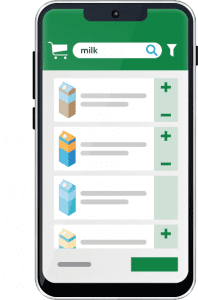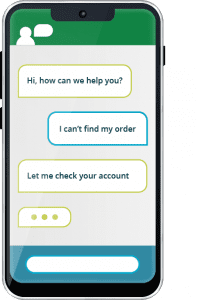
6 Food Retail Industry Digital Strategies for 2021
In the food retail industry, digital maturity correlates with higher revenue. Learn from the leading grocery retailers with these tips.
If you’re in the food retail industry and looking for ways to grow your profitability in 2021, start by ensuring that you have the technology to deliver what shoppers want.
We’ve rounded up highlights from the Incisiv Grocery Digital Maturity Benchmark 2020 report (DMBR) sponsored by Mercatus. These are key lessons to be learned from the activities of 90 grocery retailers and delivery providers with the highest annual revenues in the US, Canada, and Western Europe. These digital features will help differentiate your brand to keep shoppers returning and boost both sales and margins.
1. Scale up fulfillment

Support your customers’ needs by offering these fulfillment features:
- The ability to choose time slots and schedule orders, and ideally to offer an express option with fulfillment in the next two hours.
- Contactless payments and pick-up or delivery to protect shoppers’ need to shop safely.
- Order status notifications by text or email and the ability to track the delivery person in real-time.
- Technology that sends an alert from the customer to the store when they are on the way to pick up, enabling you to keep their parking lot wait time to a minimum.
- The opportunity to join special programs that provide free delivery and to return online purchases.
Scale your online grocery fulfillment, reduce labor costs by 30%, and have orders ready for curbside pickup within 2 minutes of arrival, with Mercatus Enhanced Fulfillment.
2. Beef up your .com

To ensure your eCommerce website is capturing shoppers:
- Ensure your Search function has the essentials like auto-complete and the ability to recognize misspelled words.
- Boost Search capabilities with the ability to provide details about ongoing promotions and item availability.
- Recommend coupons and promotions on the product description page (PDP).
- Let customers check the inventory status from the PDP and their cart.
- Allow customers to make requests for how products are selected (such as ripeness or expiry).
Discover the differentiators that will set your brand apart!
Read the full Grocery Digital Maturity Benchmark 2020 report now.
3. Connect with customers

Strengthen your connection with customers using these digital tools:
- On-demand customer service such as live chat and availability through social channels to answer questions and help new online shoppers navigate the process.
- The ability to not only register for your store’s loyalty program online but also earn points and manage their account online too.
- Easy access to account details such as order history, and receipts, and to save multiple addresses and payment details.
- Personalized recommendations based on previous browsing and purchase history create a connection by demonstrating that you remember and value the customer.
- Integration with virtual assistants to provide shoppers with greater convenience, resulting in your becoming a seamless presence in their everyday routine.
4. Work with the right food retail industry partners
Most regional grocers lack the resources to operate their own home delivery program and must of necessity contract out these services. In fact, more than 50% of online orders are delivered by a third-party service. This means the entire process — from research and discovery to online ordering, to fulfillment and customer service — is beyond the control of the retail grocer. The Digital Maturity Benchmark Report found that digital maturity amongst third-party delivery providers is far lower than for grocery retailers.
Look for food retail industry technology and service partners who can deliver the differentiating features that will bolster your reputation:
- Filters for dietary restrictions.
- Personalized product recommendations based on browsing and purchase history.
- Option to modify an order before it’s shipped.
- Option to select a desired store at the beginning of the online ordering journey.
- Ability to track delivery persons in real-time.
- Option to return online purchases in-store.
5. Own your experience
Creating a seamless, omnichannel grocery shopping experience is complex. Grocers of all sizes benefit from the right food retail industry solution partnerships to make that happen. By retaining ownership of the overall eCommerce enterprise, you can continually enhance your digital shopping platform. This way, you can be confident you are providing a best-in-class experience to your customers.
Insist on working with tech partners who can provide:
- Multi-tier architecture supported in the cloud and tightly integrated with an existing ecosystem of third-party solutions.
- Fulfillment services that can not only grow with you but facilitate your growth. This includes fulfillment source options such as a dark store, warehouse, or micro-fulfillment center (MFC), pick options, fulfillment technology, and order communication and tracking.
- Complete ownership of your customer data that resides with you.
A partnership with Mercatus empowers you to own your online grocery experience and compete in the market space, not just the marketplace.
6. Monetize your efforts
Consumer packaged goods companies (CPGs) are spending their advertising budgets where their audiences are: online. A distinct advantage of owning your eCommerce site (even if you also use a delivery-provider marketplace), is control of customer data. Only then can you provide the in-depth, high-quality data that allow CPGs to create and track targeted ad campaigns that will help you recoup additional revenues through your online experience.
Look for a program that:
- Makes it easy for you to get set up and participate.
- Allows you to collect CPG ad dollars without the addition of internal resources or financial investment.
- Provides native advertising that offers your customers a seamless shopping experience and maximizes conversion rates.
- Delivers a high return on advertising spend (ROAS) to the CPGs to ensure continued revenue from this source.
Capture your equal share of digital ad revenue, optimize grocery advertising and drive shopper loyalty with Mercatus Digital Advertising.
It’s time to put your food retail brand on the leaderboard! Read the full Grocery Digital Maturity Benchmark 2020 report to find out how.
 Newsroom
Newsroom
